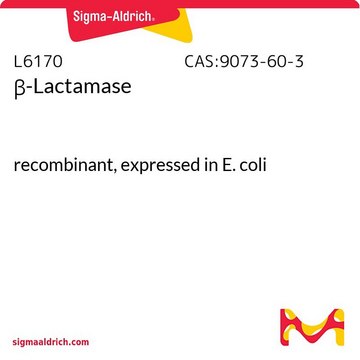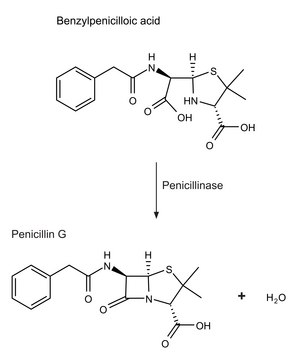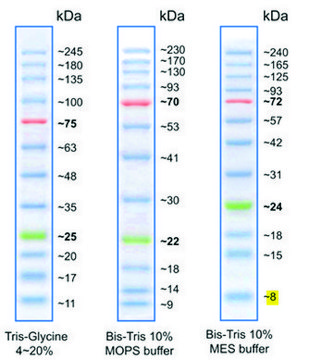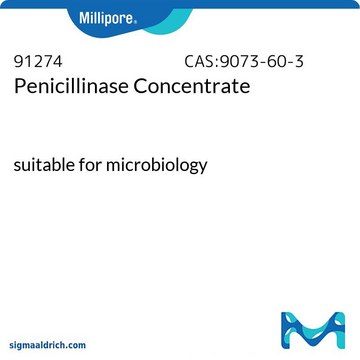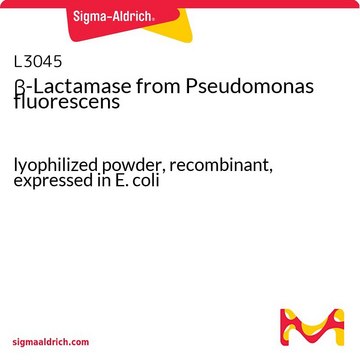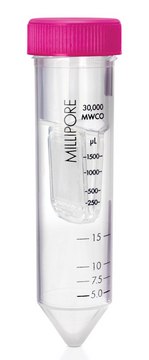推荐产品
生物来源
Bacillus sp. (Bacillus cereus)
质量水平
描述
Merck USA index - 14, 7093
表单
lyophilized
包装
vial of ≥50 units β-lactamase II
vial of ≥500 units β-lactamase I
制造商/商品名称
Calbiochem®
储存条件
OK to freeze
溶解性
sterile distilled water: soluble
运输
ambient
储存温度
−20°C
一般描述
β-Lactamase produced by bacteria shares sequence homology to penicillin-binding proteins. This enzyme is found in Gram-negative bacteria. β-Lactamases have four molecular classes, named A, B, C, and D. A, C, and D form an acyl-enzyme via active site serine residue. Class B β-lactamases are metalloenzymes, which have a zinc ion at their active site for β-lactam hydrolysis.
生化/生理作用
β-Lactamase hydrolyzes β-lactum antibiotics and is the chief cause of resistance to β-lactam antibiotics development by bacteria. Mutations in the β-lactamases are associated with extended-spectrum β-lactamases (ESBLs).
警告
Toxicity: Harmful (C)
单位定义
One unit is defined as the amount of enzyme that will hydrolyze 1.0 µmol benzyl penicillin and 1.0 µmol of cephalosporin C, respectively, per min at 25°C.
重悬
Following reconstitution, store in the refrigerator (4°C). Stock solutions are stable for up to 1 month at 4°C.
法律信息
CALBIOCHEM is a registered trademark of Merck KGaA, Darmstadt, Germany
警示用语:
Danger
危险声明
危险分类
Resp. Sens. 1 - Skin Sens. 1
储存分类代码
11 - Combustible Solids
WGK
WGK 3
闪点(°F)
Not applicable
闪点(°C)
Not applicable
法规信息
监管及禁止进口产品
Karen Bush et al.
Antimicrobial agents and chemotherapy, 54(3), 969-976 (2009-12-10)
Two classification schemes for beta-lactamases are currently in use. The molecular classification is based on the amino acid sequence and divides beta-lactamases into class A, C, and D enzymes which utilize serine for beta-lactam hydrolysis and class B metalloenzymes which
Sibhghatulla Shaikh et al.
Saudi journal of biological sciences, 22(1), 90-101 (2015-01-07)
Antibiotic resistance is a problem of deep scientific concern both in hospital and community settings. Rapid detection in clinical laboratories is essential for the judicious recognition of antimicrobial resistant organisms. Production of extended-spectrum β-lactamases (ESBLs) is a significant resistance-mechanism that
Karen Bush
Antimicrobial agents and chemotherapy, 62(10) (2018-08-01)
β-Lactamases, the major resistance determinant for β-lactam antibiotics in Gram-negative bacteria, are ancient enzymes whose origins can be traced back millions of years ago. These well-studied enzymes, currently numbering almost 2,800 unique proteins, initially emerged from environmental sources, most likely
P A Bradford
Clinical microbiology reviews, 14(4), 933-951 (2001-10-05)
Beta-lactamases continue to be the leading cause of resistance to beta-lactam antibiotics among gram-negative bacteria. In recent years there has been an increased incidence and prevalence of extended-spectrum beta-lactamases (ESBLs), enzymes that hydrolyze and cause resistance to oxyimino-cephalosporins and aztreonam.
我们的科学家团队拥有各种研究领域经验,包括生命科学、材料科学、化学合成、色谱、分析及许多其他领域.
联系技术服务部门